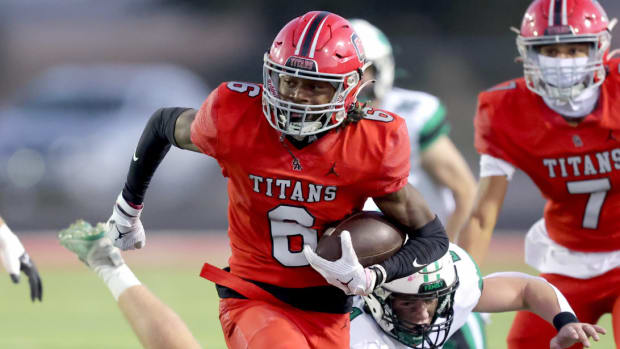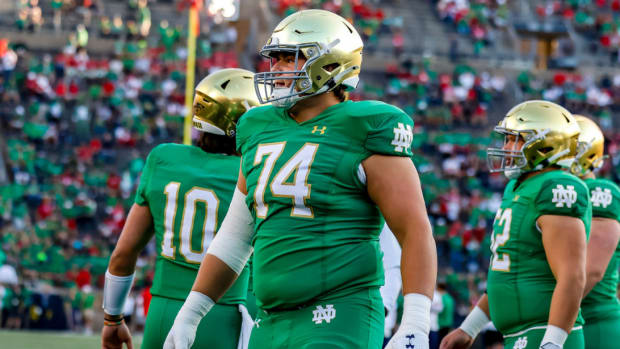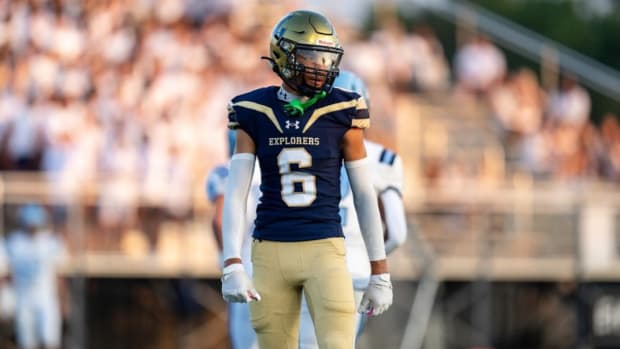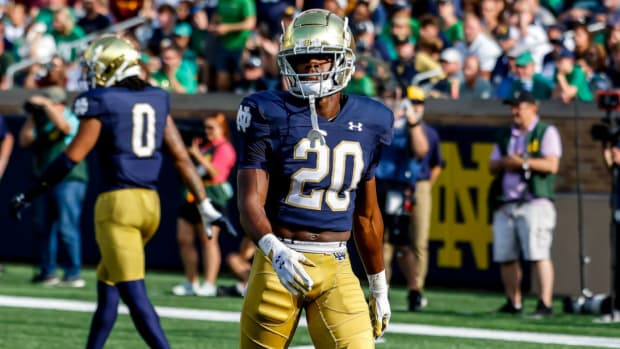Notre Dame and Navy: A Bond Forged In Blood
A tradition at Irish Breakdown is to remind Notre Dame fans, especially younger fans, of why the Notre Dame-Navy rivalry came to be, and why it's so vitally important for both teams, especially the Fighting Irish.
This is an article that was published last year by Andrew McDonough, a staff contributor for Irish Breakdown. It was such incredibly well done, and so thorough, that part of our annual Notre Dame vs Navy tradition will be to re-publish it every year as a reminder of what makes this tradition so special.
----
The year was 1942. As the Soviets battled the Germans on the Eastern Front and the Allied forces planned for the invasion of North Africa, the US Navy was hard at work fighting a two-front war.
After being caught by surprise and suffering a major setback at Pearl Harbor, the Pacific Fleet had rebounded to launch the shocking Doolittle Raid on Japan in April 1942 – shattering the Japanese feeling of invincibility – and defeat the Japanese Navy in the Battle of the Coral Sea in May and Battle of Midway in June. In the Atlantic, the Navy was protecting convoys from the dreaded German U-Boat attacks to bring starving Britain back from the brink and supply the Soviet Union with the arms to stall the German advance. With the sleeping giant of the American economy roaring back to life and supplying the Allied cause with more materials of war than ever produced in human history, the Navy was left with one major need – men.
On the home front, the nation was invested in doing its part to further the war effort. From food and fuel rations to bond, paper, and scrap metal drives, Americans were united in tightening their collective belts and making the necessary sacrifices to support their boys overseas and bring down Nazi Germany and Imperial Japan.
However, those sacrifices did not always only mean going without or using less – some had significant financial ramifications as well. One small, Catholic, all-male college in northern Indiana found itself in dire financial straits in 1942, with enrollment plunging more than 20% from its pre-war levels. With virtually the only students on campus either seventeen-year-old freshmen too young for the draft or those with physical limitations making them unable to serve in the military, Notre Dame president Rev. Hugh O’Donnell, CSC, needed to come up with a creative solution to boost enrollment and keep the doors of the university open.
----
Even back in 1943, Notre Dame – and the Irish in America – had a long history of association with the US military.
When asked to protect the union of their adopted homeland during the Civil War, tens of thousands of Irishmen answered the call. Inspired by Fr. William Corby, CSC, who would later become president of the University of Notre Dame, the famed “Irish brigade” – allegedly nicknamed the “Fighting 69th” by none other than Robert E. Lee himself – distinguished itself in battle, most notably at Antietam, Fredericksburg, and Gettysburg, all while suffering heavy casualties. At Antietam alone, the Irish Brigade suffered a 60% casualty rate. A statue of Fr. William Corby offering general absolution to the Irish Brigade at Gettysburg stands on Notre Dame’s campus, while an exact copy stands at Gettysburg on Cemetery Ridge.
As president of Notre Dame, Corby would institute military training at the university in 1880. A Notre Dame student, John Shillington would die on the USS Maine when it exploded in Havana, sparking the Spanish-American War. There is a monument to Shillington on campus near the ROTC building made from a shell from the Maine.
By the time that World War I rolled around, most Notre Dame students were required to undergo at least some military training, and Notre Dame was granted the privilege of hosting a Student Army Training Corps branch on campus (the precursor to ROTC today).
Notre Dame would send around 2,200 of its students to fight in World War I, and 46 of those young men would give their lives. Their names are immortalized in the God, Country, Notre Dame monument over the eastern entrance to the Basilica of Notre Dame, which was dedicated by university president Fr. Matthew Walsh, CSC, in 1924.
Of course, by 1920s, the fighting Notre Dame spirit – demonstrated both on and off the gridiron – was known across the nation. As football grew in popularity in the early 20th century, the millions of working class, predominantly Catholic, and many first-generation Americans searched for a team that embodied their fighting spirit and found that in Notre Dame. As the football program grew in prestige, the university adopted the moniker “Fighting Irish”, turning what was once a slur hurled at the football team by opposing fans (such as Northwestern in 1899) into a rallying cry. As previously discussed in Part II of Irish Breakdown’s series on the history of Notre Dame and the Big Ten, the first use of the nickname “Fighting Irish” by journalists was by the Detroit Free Press after Notre Dame shocked heavily favored Michigan in 1909.
In the period after World War I, Notre Dame athletes and students would demonstrate that fighting spirit whenever confronted. Irish teams traversed the country to play anyone, anywhere, while racking up 3 national titles between 1924-1930 under legendary coach Knute Rockne. Also, Irish students took a stand of their own, famously disrupting a large Ku Klux Klan rally planned for South Bend in 1924 (and forcing the Klan to cancel a second rally). The stand by Notre Dame students against the KKK while the Klan was at the height of its powers was the beginning of the end of its hold on Indiana.
Just a few years later in 1927, Notre Dame President Fr. Matthew Walsh would officially adopt the Fighting Irish as the nickname of the university athletic teams.
-----
With that context in mind, Rev. O’Donnell reached out to US military leadership and offered them the use of university facilities for training. The Army declined, but the Navy eagerly accepted.
In 1942, the Navy established the V-7 program, which was also known as the Midshipmen’s School, on the campus of Notre Dame, building a drill hall where the Hesburgh Library now stands and taking over four of the dorms. President Franklin D. Roosevelt had established the V-7 program in 1940 to with the goal of training up to 36,000 reserve naval officers for command at various universities around the country. This program involved a 30-day orientation course followed by 90-day intensive training.
For the V-7 program, the Navy paid Notre Dame $487,711 ($7.73M today) and then a monthly stipend for every enrollee. This financial infusion kept the university afloat during a very difficult time.
The Navy would expand its use of Notre Dame facilities by also establishing the V-12 program on campus in 1943. The V-12 built on the V-7 program and offered enrollees the chance to become naval officers while also being able to take undergraduate classes on the respective campuses and participate on athletic teams. According to a 2011 article by the esteemed Notre Dame football writer and historian Lou Somogyi on UND.com, the Notre Dame V-12 program was the largest in the nation and the 1943 national championship team included 14 Navy apprentice seamen, including 1947 Heisman Trophy winner Johnny Lujack, 12 transfers from the Marines, and 17 Marine privates, including the 1943 Heisman Trophy winner Angelo Bertelli.
Following the 1943 season, head coach Frank Leahy and the entire staff volunteered for active duty in the US Navy as well. With their service, they would join the around 12,000 commissioned officers who passed through the V-7 and V-12 programs at Notre Dame in the early 1940s, and as John F. Wukovits points out in the book Soldiers of a Different Cloth, 35 military chaplains from Notre Dame.
Today, Notre Dame is second to only the US Naval Academy in the number of naval officers commissioned by the university in its history.
-----
Keep this shared history and strong bond in mind when the Irish take the field on Saturday against the Midshipmen. Even though the Navy game is typically the only one on the schedule against a triple-option team, even though playing Navy means dealing with cut blocks, and even though seldom does a win over Navy mean anything in the polls (while a close win may just as well be counted as a loss), this game is not just another game. It is a matchup between institutions founded on the bedrock of respect, honor, service, and love of country that share a bond forged in blood. That still means something.
Former Notre Dame president Fr. Ted Hesburgh, CSC, summed up the bond with Navy best, stating “Navy came in and kept us afloat until the war was over” and “they’re the best friends we’ve got”.
Irish Breakdown Fans be sure to get your Notre Dame tickets from SI Tickets HERE
Be sure to check out the Irish Breakdown message board, the Champions Lounge
Irish Breakdown Content
Notre Dame 2022 Roster
Notre Dame 2022 Schedule
Notre Dame 2023 Class Big Board
Notre Dame 2023 Commits Board - Offense
Notre Dame 2023 Commits Board - Defense
Notre Dame 2023 Scholarship Offers
Notre Dame 2024 Scholarship Offers
Ranking The 2022 Signees - Offense
Ranking The 2022 Signees - Defense
———————
Become a premium Irish Breakdown member, which grants you access to all of our premium content and our premium message board! Click on the link below for more.
Be sure to stay locked into Irish Breakdown all the time!
Join the Irish Breakdown community!
Subscribe to the Irish Breakdown YouTube channel
Subscribe to the Irish Breakdown podcast on iTunes
Follow me on Twitter: @CoachD178
Follow me on Gettr: @IrishBreakdown
Like and follow Irish Breakdown on Facebook





